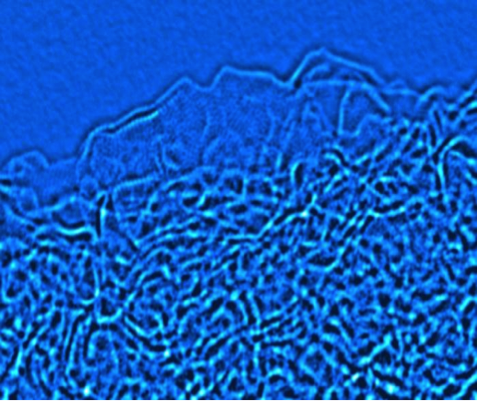Distinguished University and Trustee Chair Professor Yury Gogotsi , members of the Nanomaterials Research Group, and collaborators at University of Texas at Austin and the Paul Sabatier University in Toulouse, France have engineered an electrolyte supercapacitor system that can store a large amount of energy at extremely low temperatures.
Recently featured in the journal Nano Energy, this research suggests a vastly improved alternative to current systems that power technology at very low temperatures, which require oversized batteries that have a very low efficiency and short lifetime.
 Transmission electron image of a-MEGO. Image taken by Dr. Eric Stach of Brookhaven National Lab.
Transmission electron image of a-MEGO. Image taken by Dr. Eric Stach of Brookhaven National Lab.Anyone who has tried to start a vehicle on a very cold day understands that low temperatures adversely affect engine performance.This is in part because cold temperatures thicken motor oil, requiring extra energy to get engine parts moving, and because the battery’s ions are slowed by the cold, causing the battery to operate at very low efficiency. In the supercapacitor system developed by Nanomaterials Group researchers and their collaborators, a unique carbon nanomaterial, activated microwave exfoliated graphite oxide (a-MEGO), was combined with a eutectic mixture of ionic liquids. The a-MEGO has a high surface area and allows for a large amount of charge to be stored capacitively on its surface, while the mixture of ionic liquids has a very low melting point and a wide voltage stability window. This supercapacitor system delivers the most energy at a low temperature of -50 °C (-58 °F). Commercial supercapacitors, by comparison, use an electrolyte that will fail at temperatures below -25 °C (-13 °F). Additionally, supercapacitors will last for more than 10 years and up to 1 million charge/discharge cycles, compared to batteries that will last a couple years for about 1 thousand cycles.
This study reinforces the potential of graphene in energy storage applications, but also demonstrates that only the right combination of an electrode material and an electrolyte leads to truly outstanding performance. This opens the door to development of even better supercapacitors using safe and non-flammable ionic liquid electrolytes.